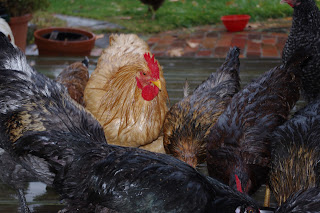Well, Ira Glass and his crew on This American Life have for several years been providing company--even fellow-feeling--as I have researched and written about chickens. That experience continues now that my book is in print. My "Culture" chapter compares the chicken portraits of Jean Pagliuso's show "Poultry Suite" (a show at the Marlborough Gallery in New York) to the genre of breed portraits stretching from Charles Darwin's colleague Tegetmeier to the American Standard of Perfection (the handbook for chicken exhibitors).
I wasn't completely surprised, then, to find that this year's Poultry Slam also considers the poultry portrait. In one of the four stories, Ira Glass interviews Tamara Staples, a poultry photographer from Chicago. Glass's commentary explores different perspectives on that classic text of chicken exhibitors, The American Standard of Perfection. Give it a listen: http://www.thisamericanlife.org/
During that same story, Ira interviews a chicken breeder. "In the country, among the chicken breeders, you think about a lot of things you never get to in the city," Ira opines. And then the eighty year old chicken keeper tells Ira about how he treated his own cancer by using "the root of the dandelion." "He's got no hard scientific proof that this really works" Ira acknowledges. Well, looking for "hard scientific proof" of old folk remedies is another one of the epistemological backflips industrial pharmaceuticals are rounding back to, just as industrial poultry farming is has decided to return to producing the so-called "natural" chicken. See the new product from Cobb-Vantress, the "Cobb Sasso 150": http://www.cobb-vantress.com/Products/CobbSasso150.aspx
In Global Nature, Global Culture, Sarah Franklin, Celia Lury and Jackie Stacey explore the power that "nature" holds as what they call a "shifting classificatory practice." They are talking about rhetorical power, among other things. This is the persuasive power packed into the term "nature" that can lead a major pharmaceutical company to prospect for potential new products in the jungle (see Londa Schiebinger's Plants and Emllpire: Colonial Bioprospecting in the Atlantic World). Or Cobb-Vantress to launch their new product line, the "Cobb Sasso 150" specifically bred, they explain, to meet the consumer preference for "slower growing, colored chicken."
Classification is at work in other ways in the Cobb-Vantress website. Note the choice of the label "chicken" in the phrase above. Despite their claim to honor "traditional free range and organic farming," their commitment to the creation of a quality controlled product is showing here. Slower growing, and 'colored' perhaps, but nature still seems to an elusive property of this new breed, which they categorize not as chickens, the species, but as chicken, the category of meat. Nature denatured, as they observe in GNGC: an intentional object always already denatured through its industrial production.
And of course there is the fact of human intervention in that shifting classificatory practice known as breeding. Here is one of my current favorite chickens: the Giant Cochin that Murray McMurray sent me as a "surprise chick."She truly is as much bigger than the other birds as she looks in these photographs. The "Biology" chapter of PSCC tells the tale of the boom-and-bust impact produced by the the importation of Cochin chickens from China in the nineteenth century.


